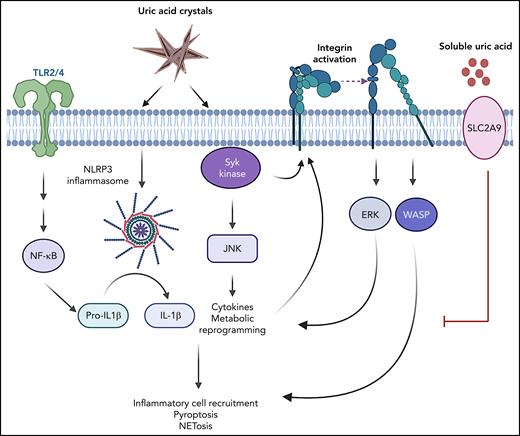In this issue of Blood, Ma et al1 report that high levels of soluble uric acid (sUA) reduce neutrophil function in patients with chronic renal failure. It is well appreciated that individuals suffering from various forms of chronic renal failure are immunosuppressed.2 Indeed, infection is the second most common cause of death in patients with kidney disease.
There are many factors that may contribute to the immunodeficiency of renal failure, but the molecular mechanisms that cause these immune defects remain poorly investigated. Clearly, both innate and adaptative immune responses can be affected. In the innate compartment, impairment of both neutrophil and monocyte/macrophage function have been reported. Monocytes from uremic patients manifest reduced cytokine production when stimulated, whereas neutrophils display reduced migratory capacity. In the mononuclear system, one of the molecular mediators of reduced cellular function was found to be high levels of sUA.3 Hyperuricemia at a level of 7 to 12 mg/dL (found in patients with more severe renal dysfunction) leads to inhibition of monocyte Toll-like receptor (TLR) signaling, which impairs cytokine production and CD14+ monocyte migration in vitro. The authors of the Ma et al article found that UA impairs β2 integrin activation and signaling, which leads to reduced neutrophil migration into inflammatory sites in vivo.
UA is taken up into cells via glucose transporter 9 (Glut9 or SLC2A9). Mice lacking SLC2A9, specifically in hepatocytes, develop moderate hyperuricemia; when the animals are fed an inosine-rich diet, they develop serum UA levels in the range of 7 to 12 mg/dL seen in humans with end-stage renal failure.4 By using this model, Ma et al found reduced neutrophil recruitment into air pouches (formed on the back of the mouse) in response to 2 different inflammatory stimuli. Most directly, this group used intravital microscopy to directly measure neutrophil rolling and adhesion in the vasculature of the hyperuricemic mice. In response to inflammatory stimuli, neutrophils in the hyperuricemic mice showed increased rolling velocity, consistent with poor integrin-mediated adhesion, that resulted in reduced transmigration of cells into the inflamed tissues. This effect was partially reversed by treating the animals with rasburicase, which lowers serum urate levels. By using human peripheral blood neutrophils, Ma et al found that exposure to high levels of UA led to poor β2 (CD18) integrin activation and cell surface recycling in vitro (to a number of inflammatory stimuli), causing reduced adhesion and chemotaxis in vitro. This mirrored the reduced in vitro chemotaxis seen in neutrophils isolated from patients with severe renal failure.
Perhaps the most interesting aspect of this biology is the dramatically different effects that soluble versus crystalline UA have on innate cells (see figure). Urate crystals, the causative agent of gout, are extreme activators of innate cells. In primed macrophages that have been exposed to TLR2 or TLR4 agonists and have high levels of pro-interleukin 1 (pro-IL-1), UA crystals lead to direct activation of the NLRP3 inflammasome complex, resulting in extreme production of IL-1β leading to an inflammatory casacade.5 Monosodium urate crystals also directly activate unprimed (or primed) macrophages, likely through a signaling pathway that involves the Syk and JNK kinases leading to cytokine production and metabolic reprogramming.6 Similar results have been reported in neutrophils exposed to UA crystals.7 UA crystals can directly bind to plasma membrane lipids, leading to the aggregation of lipid raft domains in the membrane that in turn activate Syk kinase.8
The differential effect of soluble vs crystalline UA on innate cells. Figure generated with BioRender software. ERK, extracellular signal-regulated kinase.
The differential effect of soluble vs crystalline UA on innate cells. Figure generated with BioRender software. ERK, extracellular signal-regulated kinase.
It has long been known that one of the consequences of exposure to UA crystals is integrin (CD18) activation,9 which enhances the migratory capacity of innate cells. Yet somehow, sUA does just the opposite of all this. A detailed understanding of how sUA is able to oppose β2 integrin activation remains to be provided. Because the effects of sUA on integrin activation are very rapid (experiments are performed with only a 30-minute exposure to UA), the mechanism likely involves some direct biochemical effect. Perhaps UA is competing with purine nucleotides for activation of GTPases involved in changing the integrin conformation.10 Or perhaps UA could be altering charged interactions between the signaling molecules involved in integrin activation. Working out these mechanisms will likely require significant biochemical and biophysical studies. Although it is not a major feature of this report, the authors also found that high levels of sUA affect neutrophil phagocytosis. This suggests that UA can have a broader effect on the intracellular actin cytoskeleton of innate cells, limiting membrane dynamics more generally, which may explain the reduced re-cycling of CD18 observed in these studies. Nevertheless, it is clear from this work that some aspects of the immunodeficiency seen in patients with end-stage kidney failure can be explained by the hyperuricemia that causes reduced neutrophil integrin function on top of poor monocyte and macrophage activity. This should increase the urgency for developing inhibitors for SLC2A9 to limit UA uptake into innate immune cells in patients with chronic renal failure.
Conflict-of-interest disclosure: The author declares no competing financial interests.


This feature is available to Subscribers Only
Sign In or Create an Account Close Modal